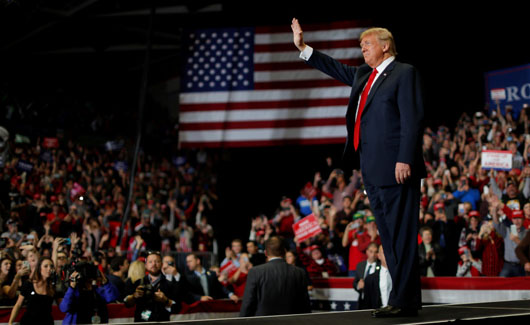by WorldTribune Staff, November 8, 2018
The Nov. 6 midterms delivered a Democratic House and Republican Senate, but never-Trumpers and anti-Trumpers are suffering from cognitive dissonance over as President Donald Trump seemed to emerge as the big winner, analysts said.
Trump and Supreme Court Justice Brett Kavanaugh are to thank for erecting a red wall that “reduced the blue wave to almost a ripple,” columnist Ralph Z. Hallow wrote for The Washington Times on Nov. 7.

“And add a nod to the caravans of Central Americans heading toward our southern border,” Hallow added. “Trump played the issue just right in refusing to get suckered in by the muddle-headed compassion-first members of his own party and the calculating Democrats who wept photogenic tears over the plight of the ‘persecuted’ caravaners.”
Hallow said Democrats can thank the late Sen. John McCain, “nominally a Republican, for contributing to the GOP’s losing the House. To get even with Trump, McCain had cast the vote that killed the Obamacare replacement that House Republicans finally, after years of dithering, had passed.”
That Republicans “couldn’t keep their Obamacare-replacement campaign pledge over eight years made them look like phonies unworthy of voters’ respect,” Hallow wrote. “With power comes responsibility and congressional Republicans turned up their noses at that maxim.”
Still, the blue wave did not materialize. If it had, Hallow wrote, “it would have allowed the Democrats, the press and the never-Trump Republicans to claim Trump is the disaster they have been saying he is. Instead, the wave turned into bubble and foam when, instead of simply holding their one-seat Senate majority, as almost universally predicted, the GOP exceeded expectations, adding three new seats by the time the dust settled.”
In Florida, the GOP won all-important contests for governor and Senate, “both with Trump’s help,” Hallow noted. “The press, the Democratic Party and most pundits regardless of party preference either predicted GOP defeat or said it was a distinct probability. Everybody was ready to declare the Trump era is all but over if Florida went belly-up for the GOP.”
Trump’s GOP did not lose anything close to the 50-60 plus House seats Presidents Bill Clinton and Barack Obama lost two years after winning the White House.
New York Post columnist F.H. Buckley noted on Nov. 7 that Trump will have many opportunities to work with the new Democratic-controlled House.
“We have two recent models for what presidents do when they lose the Congress or a branch of it,” Buckley wrote. “One model was Barack Obama in 2010 and another was Bill Clinton in 1994. For President Trump, my recommendation is 1994 and triangulation.”
The 2010 Tea Party election “was a repudiation of Obama’s overreach, of legislation Democrats passed without a single Republican vote,” Buckley wrote. “A less arrogant president might have taken a lesson from this and reached out to the other side, but Obama didn’t do any of that. He thought the arc of history bent his way, and said he had a pen and could rule by presidential diktat.”
Obama’s “overreach” wound up being “a big reason for the Republican victory in 2016, and it’s not a model Trump should repeat,” Buckley wrote.
Bill Clinton “also overreached in his first term, but unlike Obama, he reached out to Republicans after the 1994 election,” Buckley noted. “In his 1995 State of the Union Address, he told us ‘the era of big government is over.’ ”
Clinton “hired Dick Morris and proceeded to cut deals with the Newt Gingrich Republicans. That gave us highly successful welfare-reform and tax-cut legislation, and that’s the kind of triangulation that Trump should pursue now,” Buckley wrote.
Tax reform, immigration, and lobbying reform are areas the president can work with Democrats, according to Buckley.
“There’s a deal waiting to be made on tax reform, if Democrats are willing to make one. Trump wants a middle-class tax cut and said he’s willing to make adjustments to get there. That shouldn’t be hard for him.”
On immigration, “most Americans would favor a deal with the following three elements: amnesty for the Dreamers, funding for a wall and fixing legal-immigration idiocies. Democrats in the past have signaled some support for the wall in return for help for the Dreamers,” Buckley wrote.
“But what about the crazy lottery for legal immigrants, or bringing in a greater proportion of legal immigrants based on their skill set? It’s a $20 bill lying on the sidewalk, and Trump should ask the Democrats if they want to pick it up.”
Meanwhile, lobbyists donate billions to campaign chests, frequently outpacing more than all Super PAC and presidential campaign giving combined, Buckley noted.
“What that’s given us is America’s pay-for-play networks in which lobbyists and their clients are rewarded for their campaign contributions by government favors from public officials. And that weakens our economy.”
Trump ran against the swamp, “but two years later it’s as big as ever,” Buckley noted. “Democrats want to claim the clean-government mantle, and Trump should work with them on lobbying reform.”
Subscribe to Geostrategy-Direct __________ Support Free Press Foundation
